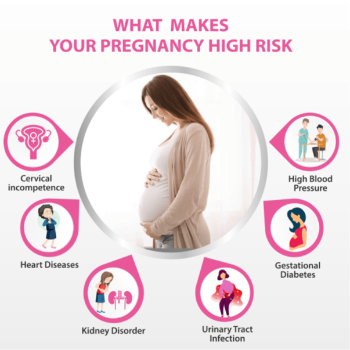Hospitals Available with this High-Risk Obstetrics Care Treatment





Department: Gynaecology
Estimated Cost : $5,000 - $15,000
High-risk obstetrics care refers to the specialized medical care provided to pregnant women who face an increased risk of complications during pregnancy, childbirth, or both. This includes women with pre-existing health conditions, those who develop pregnancy-related complications, or those who experience other factors that may impact the health of the mother or baby. High-risk pregnancies require careful monitoring and management to ensure a safe pregnancy and delivery.
Common conditions that may categorize a pregnancy as high-risk include:
Symptoms and warning signs that may indicate a high-risk pregnancy include:
If you experience any of these symptoms, it is crucial to seek immediate medical attention to ensure both your safety and the safety of your baby.
High-risk pregnancies are diagnosed through a combination of medical history review, physical exams, and specific diagnostic tests. Some common diagnostic methods include:
Management of a high-risk pregnancy will depend on the specific risk factors and complications involved. Treatment options include:
1. Specialized Prenatal Care
Women with high-risk pregnancies may require more frequent prenatal visits. This includes routine monitoring through ultrasounds, fetal heart rate monitoring, and regular blood tests to track the mother’s health and the baby’s development.
2. Medications and Supplements
Depending on the condition, medication may be prescribed to manage health concerns such as:
3. Bed Rest or Activity Restrictions
In some cases, bed rest or reduced physical activity may be recommended to manage certain complications, such as preterm labor or placenta previa.
4. Hospitalization
If the pregnancy is highly complicated, hospitalization may be required for monitoring and managing health concerns like preeclampsia, gestational diabetes, or severe fetal growth restriction.
5. Monitoring for Preterm Labor
Women at risk for preterm labor will be closely monitored. Medications like corticosteroids may be given to help the baby’s lungs mature in case of an early delivery.
6. Delivery Planning
The method and timing of delivery for high-risk pregnancies will be carefully planned. This may involve scheduling a cesarean section (C-section) if vaginal delivery poses a risk to the mother or baby. Close monitoring during labor and delivery ensures that any complications are addressed promptly.
If you are facing a high-risk pregnancy or have concerns about potential complications, our team is here to help. Contact us today to schedule a consultation and receive expert, compassionate care for your pregnancy.
1. What is a high-risk pregnancy?
A high-risk pregnancy is one where there is an increased chance of complications affecting the mother, the baby, or both during pregnancy, labor, and delivery. This may be due to pre-existing health conditions, pregnancy-related complications, or other risk factors.
2. What are common causes of a high-risk pregnancy?
Common causes include pre-existing medical conditions like diabetes, hypertension, or heart disease, as well as pregnancy-related complications such as preeclampsia, gestational diabetes, multiple pregnancies (twins or more), and advanced maternal age (over 35 years).
3. How do I know if I have a high-risk pregnancy?
If you have any of the risk factors such as chronic health conditions, previous pregnancy complications, multiple gestations, or other concerns, your doctor will closely monitor your pregnancy. You may also experience warning signs like severe swelling, vision changes, or abnormal bleeding that require immediate attention.
4. How is a high-risk pregnancy managed?
Management involves frequent prenatal visits, specialized tests like ultrasounds and blood work, and possibly medications to manage conditions such as high blood pressure or gestational diabetes. In some cases, bed rest or early delivery may be recommended.
5. Will I need a cesarean section if I have a high-risk pregnancy?
Not necessarily. While some high-risk pregnancies may require a cesarean section (C-section) for the safety of the mother or baby, many women with high-risk pregnancies can still have a vaginal delivery. The method of delivery will be determined based on individual circumstances and complications.
6. What types of monitoring will I need during a high-risk pregnancy?
You may need more frequent ultrasounds, non-stress tests (NSTs), fetal monitoring, blood pressure checks, and regular lab tests to assess both your and your baby's health. Monitoring helps ensure early detection of any issues and allows timely intervention.
7. Can I still have a healthy pregnancy with a high-risk condition?
Yes, many women with high-risk pregnancies have healthy babies. With proper monitoring, management, and care, most complications can be managed, improving the chances of a positive outcome for both the mother and baby.
8. What are the signs of a high-risk pregnancy?
Signs to watch for include severe abdominal pain, heavy bleeding, sudden swelling of the face or hands, blurry vision, headaches, dizziness, or a decrease in fetal movement. If you experience any of these symptoms, contact your healthcare provider immediately.
9. Is high-risk pregnancy care covered by insurance?
In most cases, high-risk pregnancy care is covered by insurance, but it depends on your specific plan. It’s important to check with your insurance provider to understand the coverage for prenatal visits, testing, medications, and hospitalization, if necessary.
10. Can a high-risk pregnancy result in premature birth?
Yes, certain conditions associated with high-risk pregnancies, such as preeclampsia, multiple gestations, or fetal distress, may increase the likelihood of premature birth. However, with careful management and timely medical interventions, the risk of premature birth can often be reduced.
@2025 Healtour Solutions Pvt Ltd. All Rights Reserved.